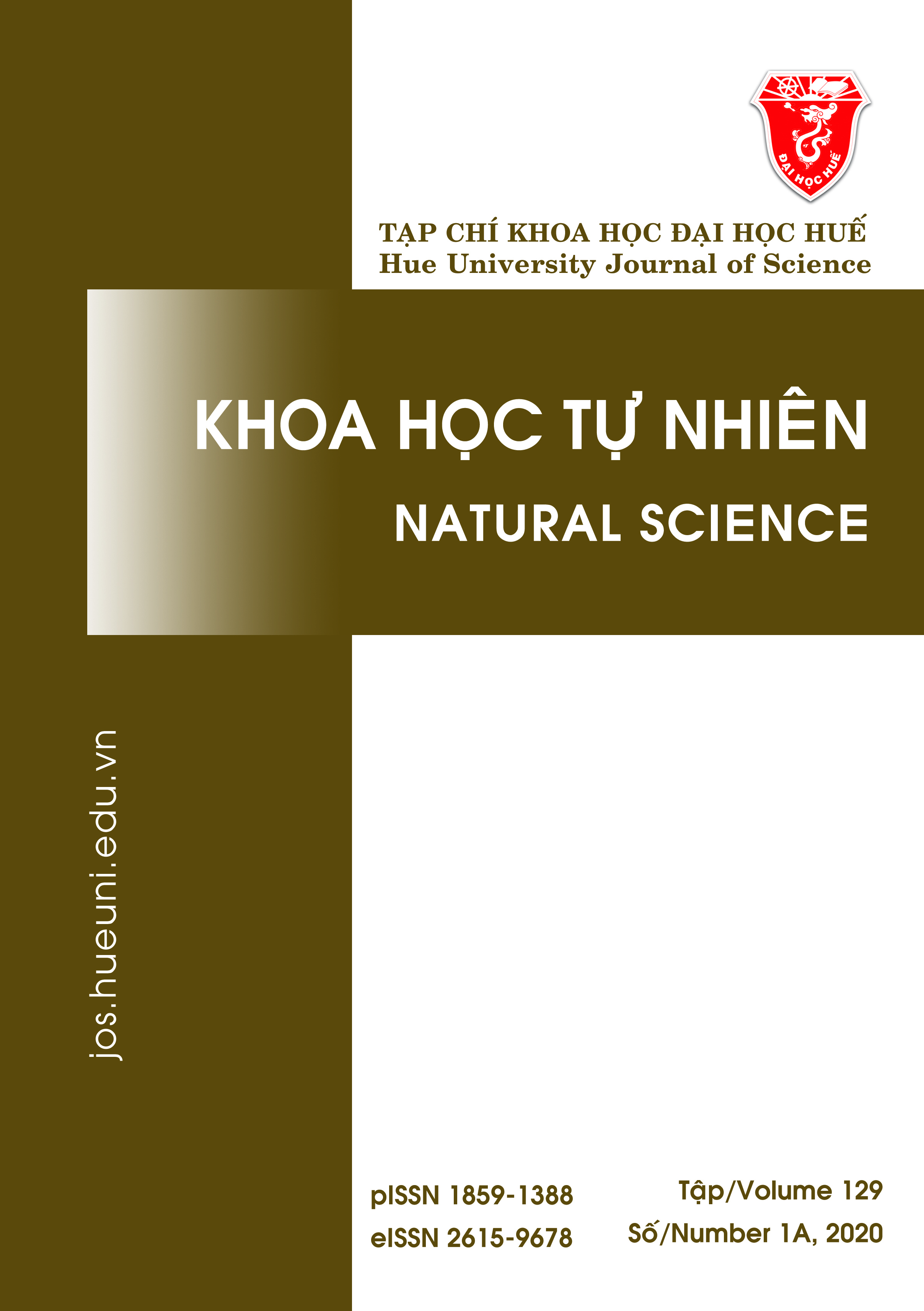Tóm tắt
Bài báo trình bày kết quả nghiên cứu đặc điểm hình thái và phân bố của loài rong cám Najas indica ở đầm Cầu Hai trong khoảng thời gian từ tháng 3/2018 đến 3/2019. N. indica có phân bố khá rộng ở đầm Cầu Hai, từ khu vực giữa đầm hướng vào bờ phía Tây, có mặt ở 10/21 điểm khảo sát. Độ phủ và sinh khối của N. indica có sự khác biệt ở các tháng khảo sát. Độ phủ và sinh khối của rong bắt đầu gia tăng từ tháng 4. Độ phủ cao nhất đạt được trong khoảng thời gian từ tháng 7 đến 11 (49,33 ± 15,05%÷52,60 ± 12,28%) và sinh khối đạt cực đại vào tháng 7 (93,61 ± 35,60 g/m²); sau đó giảm dần. Độ mặn và nhiệt độ không khí thể hiện sự ảnh hưởng đến biến động phân bố của N. indica ở đầm Cầu Hai, trong đó, nhiệt độ không khí có mối tương quan chặt với sinh khối còn độ mặn chỉ thể hiện tương quan yếu với sinh khối và độ phủ của loài.
Tài liệu tham khảo
- Tiến NV. Cỏ thủy sinh đầm phá Thừa Thiên Huế –Báo cáo chuyên đề đề tài: Điều tra khảo sát các bãi giống, bãi đẻ của các loài thủy sản kinh tế hệ đầm phá Thừa Thiên Huế và đề xuất các giải pháp bảo vệ Thừa Thiên Huế (VN): Sở Khoa học Công Nghệ và môi trường Thừa Thiên Huế; 2000.
- Tien NV. Seagrass in the South China Sea – National report. Bangkok (Thai): UNEP/GEF; 2008.
- Polidoro B, Brooks T, Carpenter K, Edgar G, Henderson S, Sanciangco J, et al. Patterns of extinction risk and threat for marine vertebrates and habitat-forming species in the Tropical Eastern Pacific. Marine Ecology Progress Series. 2012;448:93-104.
- Short FT, Polidoro B, Livingstone SR, Carpenter KE, Bandeira S, Bujang JS, et al. Extinction risk assessment of the world’s seagrass species. Biological Conservation. 2011;144(7):1961-1971.
- Hộ PH. Cây cỏ Việt Nam – Tập III. Hồ Chí Minh: Nxb Trẻ – tp Hồ Chí Minh; 2001.
- Pháp TT. Đa dạng sinh học phá Tam Giang – Cầu Hai, Thừa Thiên Huế. Huế: Nxb Đại học Huế; 2009.
- Pháp TT, Đốc LQ, Tuấn LQ. Phân bố cỏ thủy sinh bậc cao ở phá Tam Giang–Cầu Hai. Tạp chí Khoa học & Công Nghệ, sở Khoa học, Công nghệ và Môi trường, Thừa Thiên Huế. 2001;2(32):45-51.
- Tripathi RD, Singh R, Tripathi P, Dwivedi S, Chauhan R, Adhikari B, et al. Arsenic accumulation and tolerance in rootless macrophyte Najas indica are mediated through antioxidants, amino acids and phytochelatins. Aquatic Toxicology. 2014;157:70-80.
- Hằng PTT, Hương NTT, Đốc LQ, Pháp TT. Thành phần loài cỏ thủy sinh sống chìm ở đầm Cầu Hai , tỉnh Thừa Thiên Huế. Tạp chí Khoa học & Công Nghệ, Trường Đại học Khoa học, Đại Học Huế. 2016;5(1):87-94.
- Phan TTH. Submerged Aquatic Vegetation in a Tropical Coastal Lagoon Environment Dynamics and Resilience Strategy [dissertation]. Brussel: Vrije Universiteit Brussel; 2018. 193 p.
- Pháp TT. Nghiên cứu thực vật thủy sinh ở phá Tam Giang, tỉnh Thừa Thiên Huế [luận án]. Hà Nội: Trường Đại học Tổng hợp Hà Nội; 1993.
- Anh TNQ, Lương Quang Đốc LQ. Hiện trạng cỏ thủy sinh ở khu bảo vệ thủy sản cồn Chìm, phá Tam Giang–Cầu Hai. Tạp chí Khoa học Đại học Huế. 2013;73(4).
- McKenzie LJ, Campbell SJ. Seagrass-watch: Manual for community (citizen) monitoring of seagrass habitat. Queensland (AU): Western Pacific Edition (QFS, NFC, Cairns); 2002. 43 p.
- McKenzie LJ. Guidelines for the rapid assessment and mapping of tropical seagrass habitats. Queensland (AU): Department of Primary Industries. The State of Queensland; 2003. 46 p.
- Short FT, Coles RG. Global Seagrass Research Methods. Amsterdam : Elsevier Science B.V; 2001.
- Tripathi RD, Singh R, Tripathi P, Dwivedi S, Chauhan R, Adhikari B. Arsenic accumulation and tolerance in rootless macrophyte Najas indica are mediated through antioxidants, amino acids and phytochelatins. Aquat Toxicol. 2014;157:70-80.

công trình này được cấp phép theo Creative Commons Ghi công-Chia sẻ tương tự 4.0 License International .
Bản quyền (c) 2020 Array




